We are getting tired of having to stick up for the 350cc power plant just because most professional racers don't race one, so we are just going to be blunt here. A majority of casual to even serious moto riders don’t need and can’t use all of the brute force of a modern 450. And yes, the KTM 350 SX-F really does have the the positive characteristics of both the 250 and 450 SX-Fs. If you are in the market for a new bike to ride at you favorite tracks, give a 350 a good hard look. For 2017 KTM gave the same changes to all of the SX-F bikes and they are: WP AER 48 fork, aluminum upper engine mounts, softer rear spring, traction control, stiffer top triple clamp, 10mm longer brake pedal, and new handlebar clamps.
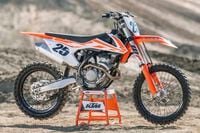
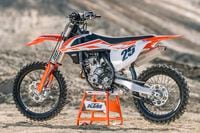
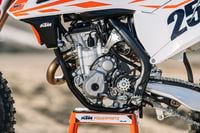
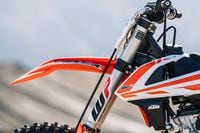
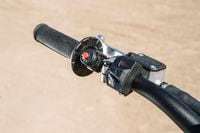
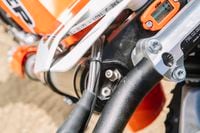
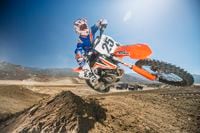
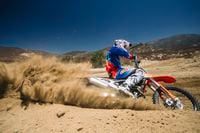
/cloudfront-us-east-1.images.arcpublishing.com/octane/D3GB6FLJVVDDVCJPJR3ZG276DI.jpg)
/cloudfront-us-east-1.images.arcpublishing.com/octane/PXDBJAHBNFHIPIII2RETRYIHV4.jpg)
/cloudfront-us-east-1.images.arcpublishing.com/octane/IP7MOVDXWFCGJH5HQHH4T44UJI.jpg)
/cloudfront-us-east-1.images.arcpublishing.com/octane/Y4EZFRIEQRE7ZFINGRA2ONFGGQ.jpg)
/cloudfront-us-east-1.images.arcpublishing.com/octane/UIVE2WGHJRCGNLMDXYO2YR27PA.jpg)
/cloudfront-us-east-1.images.arcpublishing.com/octane/XVCN7KNMTFDHZMKMCH5DU5YZRU.jpg)
/cloudfront-us-east-1.images.arcpublishing.com/octane/DTPGQUZAIZAZNPRXG4V6QATIVM.jpg)
/cloudfront-us-east-1.images.arcpublishing.com/octane/Y7EYU3ZTTJFLZEA75REMWWBLSQ.jpg)
/cloudfront-us-east-1.images.arcpublishing.com/octane/TGSYZNI7UVEI7K7ULLVVQ324A4.jpg)
/cloudfront-us-east-1.images.arcpublishing.com/octane/XGKGRRHXPNDRBGPCV4FUAARLRE.jpg)
/cloudfront-us-east-1.images.arcpublishing.com/octane/4MNSJWN6UFEMTDQHVLM52C3X44.jpg)
/cloudfront-us-east-1.images.arcpublishing.com/octane/U6X2X4HGPNCYTNMPYOAN4IIJ5Q.jpg)
/cloudfront-us-east-1.images.arcpublishing.com/octane/B6ZIPVYSKVA3LHDJTGAEEMN4VM.jpg)
/cloudfront-us-east-1.images.arcpublishing.com/octane/I24MVSJBNZDALNIYUHHPVFWNZM.jpg)
/cloudfront-us-east-1.images.arcpublishing.com/octane/SIAXQ2ZOPNBYBLPKJPCHIYGG6A.jpg)
/cloudfront-us-east-1.images.arcpublishing.com/octane/2K6UXOH6I5E4HBKQVMPKA74RR4.jpg)
/cloudfront-us-east-1.images.arcpublishing.com/octane/B52ZU5WMNVF4FDYDONLARN26VU.jpg)
/cloudfront-us-east-1.images.arcpublishing.com/octane/7J4I2LIBRZB4DILKSLG54USBH4.jpg)
/cloudfront-us-east-1.images.arcpublishing.com/octane/LALZDRL5ORHUDGKA562HKNQQBM.jpg)
/cloudfront-us-east-1.images.arcpublishing.com/octane/4QSCGKH4JZACROBHROI55V6UBM.jpg)
/cloudfront-us-east-1.images.arcpublishing.com/octane/RMQHF3KBVVHVDAXXG66W7VFKMQ.jpg)
/cloudfront-us-east-1.images.arcpublishing.com/octane/3PZSH55PPRCILD6HP4LPQSQ6OY.jpg)
/cloudfront-us-east-1.images.arcpublishing.com/octane/RRB2FJLHGBGEBMP3R2Y4BUZH4M.jpg)
/cloudfront-us-east-1.images.arcpublishing.com/octane/SGDP7TBNIZCAXIPELLUO4EFFHI.jpg)